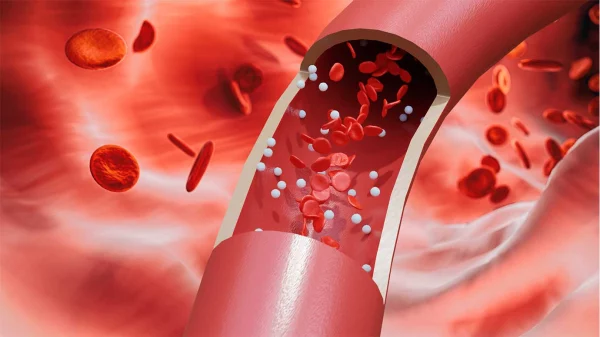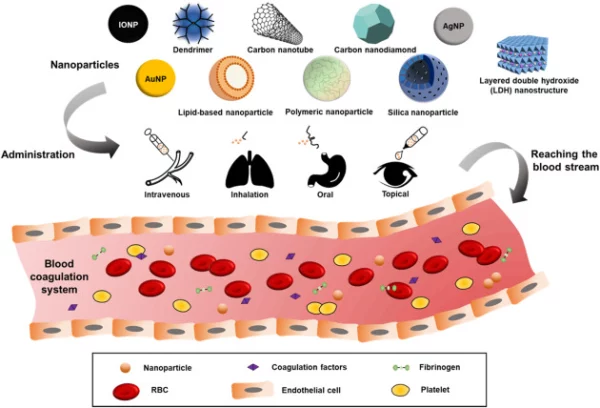Blood clots are the primary cause of severe cardiovascular conditions such as strokes and heart attacks, making them a leading factor in global mortality. Recent research by scientists at Stanford University has introduced a groundbreaking nanotechnology device that offers significant hope in treating these conditions. This device employs nano-sized particles capable of rapidly and effectively dissolving blood clots.
This nanotechnology utilizes nanoparticles coated with a compound designed to break down clots in the body. These particles are equipped with an outer layer containing specific antibodies, enabling them to accurately identify and target activated platelets—key contributors to clot formation. When injected into a patient’s body, these nanoparticles automatically seek out blood clots and release clot-dissolving compounds without damaging surrounding tissues or cells. This not only alleviates vascular blockages but can also save lives in critical emergencies.

“This technology can be deployed directly at the scene without requiring specialized medical equipment, which is especially crucial in cases such as strokes or heart attacks.” – (According to research by Stanford University, 2024).
What makes this technology revolutionary is its immediate applicability without the need for complex medical devices. In emergencies, such as when a patient suffers from a stroke or heart attack, paramedics can use this nanotechnology to save lives without the need to transport the patient to a hospital right away. The nanoparticles enter the body and resolve vascular blockages on-site, significantly increasing survival rates and reducing the risk of severe complications.
“We have successfully tested this technology on animals and are now moving toward clinical trials in humans. This technology not only has the potential to save stroke patients but could also pave the way for treating other cardiovascular conditions.” – (University of Massachusetts Medical Center, 2024).
The nanotechnology has been successfully tested on animals and is now poised for clinical trials in humans. Scientists believe this innovation will revolutionize the treatment of cardiovascular diseases, improving survival rates and mitigating severe consequences caused by blood clots. However, clinical trials will be essential to ensure the safety and efficacy of this technology for human use.

One of the standout features of this technology is its ability to save lives at the scene without the need for sophisticated medical equipment, enhancing emergency response capabilities. This not only eases the burden on the healthcare system but also provides a lifeline for patients in remote areas lacking adequate medical facilities.
This nanotechnology also marks a significant leap in the application of nanomedicine to tackle complex health issues. If proven successful, it could be widely adopted to treat not only strokes and heart attacks but also various other cardiovascular diseases. Upcoming trials will assess the technology’s effectiveness in real-world scenarios, ushering in a new era for treating life-threatening conditions.


HPX24h > Science > Nanotech Technology to Destroy Blood Clots: A New Breakthrough in Stroke and Heart Attack Treatment
Top Reads from This Category
Science
Stem Cell Therapy for Lung Cancer: A New Hope Entering Human Trials
Science
Laser Therapy Could Help Regrow Your Teeth – Did You Know?
Science
Discovery of a New Stem Cell: A Major Advancement in Creating Human Organs
Science
Turning Dreams On and Off with Brain-Control Technology: A Breakthrough in Sleep Researc
Science
Work 3.5 Days a Week and Live to 100: This Could Be Your Future
Science
AI Can Simulate Evolution and Create Proteins – A New Opportunity for Breakthrough Medical Therapies
Science
Recreating the Mouse Brain in a Virtual World: The Future of Neuroscience
Discover New Topics
Science
Science Uncovers the Brain’s Process of Storing New Ideas
Healthy Eating
The optimal diet for leaky gut syndrome: Scientific solutions and practical advice
Healthy Eating
Effectively Lower Blood Pressure with 4 Common Kitchen Vegetables
Animals
Baboons With Stable Relationships Live Longer and Show Greater Kindness
Science
Mind-Controlled Prosthetics: A Groundbreaking Advancement in Medicine
Fitness
Walking or Running: Which Is Better for Health and Weight Loss?
Space
The Smallest Star System with Three Exoplanets Found by NASA’s Kepler
Space
The Journey to Unveiling the Mysteries of Ancient Martian Oceans
Space
Exploring Gravitational Forces and the Evolution of the Universe
Science
Blood Test: A Breakthrough in Early Detection of Alzheimer’s Disease
Healthy Eating
Does Drinking Water Help with Weight Loss? The Science Behind It and How to Apply It Properly
Space
Scientists Believe Water Ice Could Exist on the Giant Asteroid Vesta
Animals
Why Bedbugs Thrive Through Inbreeding